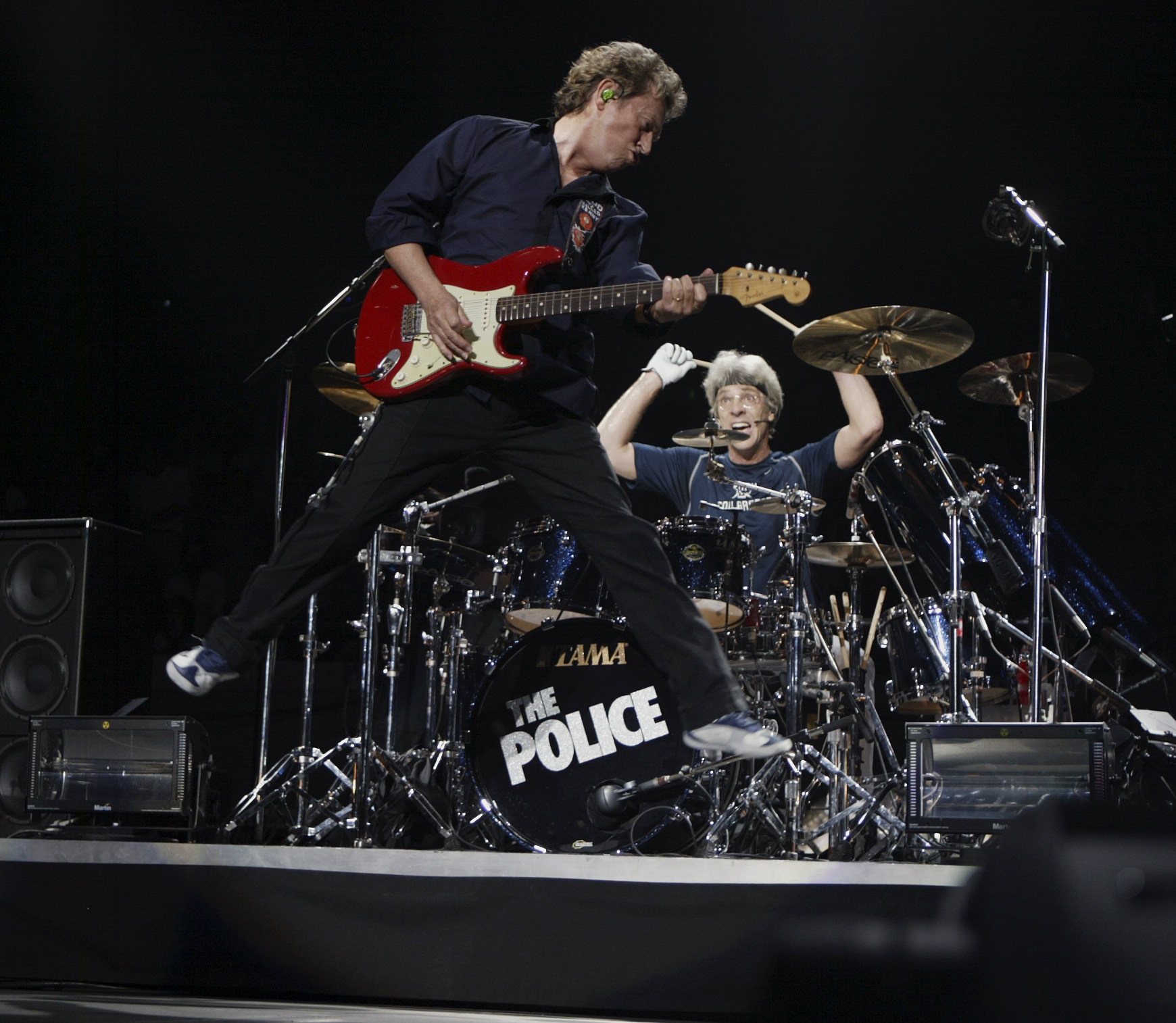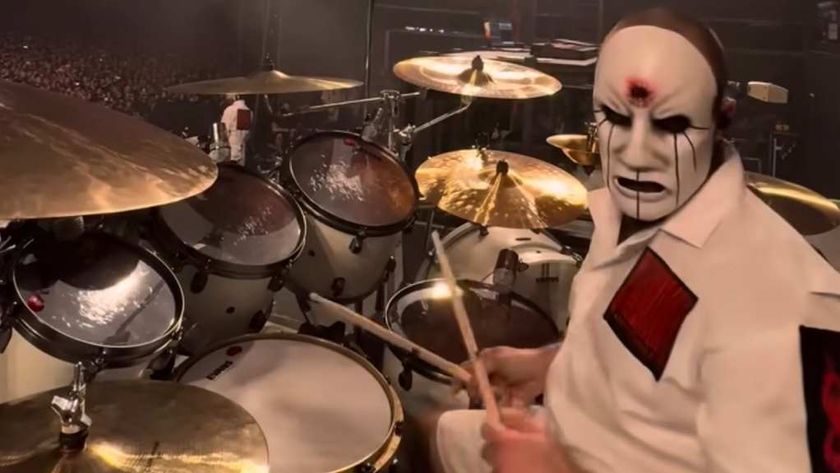Classic Drum Sounds: 'Reggatta De Blanc'
Stewart Copeland on recording the pioneering Police track

In the February 2014 issue of Rhythm, on sale now, our monster cover feature presents the stories behind 10 of the most iconic drum sounds ever recorded and we show how you can create them yourself, with audio and video examples, mixing techniques, miking ideas and more!
As part of the feature we spoke to some of the drummers, producers and engineers involved in the tracks to add their expert take on things. We got so much information we couldn't fit it all in the magazine, so here we present some bonus material, deleted scenes if you will.
In this interview Police drummer Stewart Copeland recalls how he achieved the delay effect on the track 'Reggatta De Blanc'.
Was it difficult for you to get the hi-hat and cross stick intro to work in time with the delay?
"Not at all. In fact, the delay was a chance discovery which made cool hi-hat stuff really easy. It was a simple trick which is a one repeat delay, so it doesn't have multiple delays and it doesn't build up, it's just one repeat and that makes it much more crisp and with different settings you can get different rhythms. The basic one, which turned into a guitar technique that you can hear all over not only Police albums but U2 albums as well is the dotted eighth note, or quarter note, delay. What that means is, when you go 'chunk, chunk, chunk, chunk, chunk,' the delay of it is a repeat of the one before the last chunk that you played so the result is 'chugga-chugga-chugga-chugga'. Instead of it just being hit-repeat-hit-repeat, it's hit and then repeat that you're hearing is a repeat of the hit before the last hit. Am I making any sense? It's one step removed and the note value is either a dotted quarter note or a dotted eighth note."
And this was an accidental discovery?
"Sort of. One afternoon when we got a pay day, we were touring in America and one day we were in New York with money in our pockets and we went down to Manny's Music store on 48th Street, a dream of many musicians to go down to Manny's. We just picked instruments off the wall. Sting and I both bought Stratocasters, loaded up on Roland amplifiers as Roland was the brand of the day. We got every Roland device they made - Sting and Andy each got a set of bass pedals, amps, and delay lines. The Roland Space Echo, Andy got one, so I wanted one too and I got me one.
Get the MusicRadar Newsletter
Want all the hottest music and gear news, reviews, deals, features and more, direct to your inbox? Sign up here.
"The next day at soundcheck out in Long Island, we brought all our new toys, arrayed on the stage. They're trying to get the sound together and we're playing with all our new toys! With my new Roland amp and my new Roland echo device, I'm sitting there playing my drums and I haven't got a guitar but I want to play with my echo, so I put my snare drum through the echo. Within seconds, 'whoa! This is cool!' And so we spent the afternoon in an orgy of repeat echo and totally f**ked up the gig that night with repeat echo and that was the beginning of it. It became more refined. I had a foot switch where I could switch it on and off so I could have it for the verse and then switch if off for the chorus when I don't want all that clattering going on. There were other ramifications where sometimes I could feed the kick to it and other times it's on the snare drum and other times on the hi-hat."
On the track did you gate your snare or any of your drums?
"Yes, those were the days of gating. It was just going out of fashion at the time though we did do it because it controlled the sound and you could really make the drums punch. It was overdone in the '70s, gating and compression, but I still do it to this day. It just clears the sound so what you have coming out of the speakers is what you really want. You have to do it so that you can't hear it - you can't hear the gates clicking on. But once you've gated, for instance, the tom-toms you can leave that channel up really loud without having them go 'ooohhhhhh' throughout the track."
Hugh Padgham talked about the virtue and value of compression in the studio.
"Oh yeah, compression is instant power. It can be overdone and it has to be done cleverly but it's not rocket science."
Did you use a mixture of close and room mics on the track?
"When we started working with Hugh, he turned us on to really dramatic use of room mics but when we recorded 'Reggatta…' we had overheads but not room mics because the band was clattering away in the same room, big Marshall amplifier and Sting pumping away, so room mics would not have been that useful for the drum set. In the Hugh Padgham era, we had the drums in a different room, up in the dining room, three guys in three rooms. For 'Reggatta…' we were all together."
Did it change the way you all played not having everyone in the same room?
"Yes it did change. It not only changed the way we play together but it changed the way we interact and exchanged ideas and the overall big picture artistic enterprise was a price we had to pay for getting a better drum sound. Was it worth it? Let's just say, we got away with it."
When you used the delay live, was it difficult to stop it feeding back?
"It was only one repeat, that's how you stop it feeding back, except that with monitors, the whole thing would come out of the monitors one way or another and that would go back into the system, so yes there is a danger even with a single repeat just because of the monitors. That was before they invented earwigs. In-ear monitoring didn't exist at the time."
Did you use in-ear when you did the big reunion tour?
"Yes, a mixed blessing. There is a price to pay for that too. In rehearsal you're all standing on stage and nobody can hear each other. 'Hey, when we get to the chorus can you...?' 'What? What?' You literally have to have little headset microphones so that we can talk to each other ten feet away. The advantage for the engineer getting the sound out front is that there isn't another set of noise coming out of the wedges, it makes life much easier. For The Police, getting a good stage sound was never a problem because it was just one guitar, one bass and one voice so it's not rocket science to get a good sound."
Any tracks that stand out for you that exemplify your drum sound?
"I would say that 'Can't Stand Losing You', which actually is the father of 'Reggatta De Blanc', and 'Message In A Bottle' probably. 'Reggatta De Blanc', fun fact, is officially album filler. Technically, it is totally album filler. When we came in to record our second album, you know the old adage, you have your whole life to write your first album and six months to write your second album. So we showed up for our second album having just been touring non-stop every night crossing America, conquering the world, and when we got to the studio we had two-thirds of an album worth of material. The rest of it we came up with there is the studio. 'F**k! We just need four more minutes! We need four more minutes!' Okay boys, we walked out into the studio and played something. Actually, it's a really cool track, I love that track and 'Reggatta De Blanc' actually was the stage jam from 'Can't Stand Losing You'. We would play 'Can't Stand Losing You' and then at a certain point we would go off into a reverie which turned into a jam which eventually, as we were playing it every night, evolved and evolved and became this anthem-like, call and response thing. We're in the studio, 'Aw, s**t, now what? Let's just play that!' And so we concocted an album track out of that stage jam."
Do you have a go-to head configuration and tuning methodology?
"The basic principle is very tight, very high-pitched because the action is faster, they are more responsive, they are bouncier, and because they cut through better and fatness is just inevitable and can be augmented through the PA. A common mistake made by drummers in the soundcheck is that they get their sound by going, 'Doom, doom, dooom...' and they think, 'That sounds f**king great! Deeper, deeper!' Come the gig and the guitars are bladding away, you can never hear any of that. At the soundcheck, if you're going, 'Ding, ding, dang, dong' it doesn't sound like much but when the band kicks in, they're still there."
I seem to remember you saying that one common mistake people make when they want to sound like John Bonham is that they tune their snare too low.
"John Bonham is unique in the amount of old wives tales, remedies, mystical quotations about his sound, it really is a Holy Grail, the John Bonham sound. Even Jimi Hendrix, every guitarist knows how he did it - they can't play like him but they know exactly how to get that sound. But Bonham, nobody has ever cracked it, so with him more than any other drummer, there are legends, there are tales, there are secret recipes for how he got that sound. For one thing, he did a lot of it on a Vistalite drum set, which boggles the mind. I had one of those - the worst sounding drums ever made! My god! And then there is all the discussion - skinny sticks/fat sticks; he played hard, he played light; he tuned his drums high, he tuned them low."
Did you have any particular studio techniques for capturing your drum sound?
"I record under the drums, under the toms, down on the floor and under the snare drum. If you've got a channel free, record underneath the drums, compress that and there is a lot of snap, crackle and pop underneath the drum set, underneath the snare and underneath the toms."
Do you have to deal with snare buzz?
"Not if you are playing the Stewart Copeland Signature snare drum by Tama. The whole thing about my snare drum is that it is very, very, very tight, so tight it gives a shot that will bring a bird out of the sky. Part of that is a very tight snare response, so there is not a lot of flapping around."
Want your drum recordings to sound like Stewart Copeland on 'Reggatta De Blanc'? Find out more in the latest issue of Rhythm.











